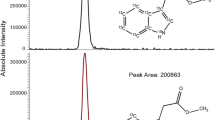Abstract
Protoplasts preparated from dark grown seedlings of Pinus sylvestris L. were incubated with 3-indole (1-14C) acetic acid and 3-indole (2-14C) acetic acid (IAA). Three catabolites were consistently produced in the (2-14C) IAA feeds, one of which co-chromatographed with 3-indole methanol on reversed phase high performance liquid chromatography (HPLC). Protoplasts feed with (1-14C) IAA produced only one labelled catabolite. The non-decarboxylated compound formed was highly polar on reversed phase HPLC, both in the ion suppression and the ion pair mode. The substance was not hydrolysable at pH 11 and 100° indicating that it is not a conjugated form. Effects of time of incubation, pH and the cofactors hydrogen peroxide and 2,4-dichlorphenol on the catabolic rate of IAA are discussed.
Similar content being viewed by others
Abbreviations
- BSA:
-
bovine serum albumin
- DCP:
-
2,4-dichlorophenol
- HPLC:
-
high performance liquid chromatography
- IAA:
-
3-indole acetic acid
- IAld:
-
3-indole carboxaldehyde
- ICA:
-
3-indole carboxylic acid
- IM:
-
3-indole methanol
- MES:
-
4-morpholineethane sulfonic acid
- MO:
-
3-methyl-oxindol
- MnO:
-
3-methylene-oxidol
- OxIAA:
-
3-oxindole acetic acid
- PEG:
-
polyethylene glycol
References
DAVID, A. and H. DAVID (1979). Isolation and callus formation from cotyledon protoplasts of pine (Pinus pinaster). — Z. Pflanzenphysiol. 94, 173–177.
Faye, M. and A. David (1983). Isolation and culture of gymnosperm root protoplasts (Pinus pinaster). — Physiol. Plant. 59, 359–362.
GALUN, M.E. (1981). Plant protoplasts as physiological tools. — Ann. Rev. Plant Physiol. 32, 237–266.
GRAMBOW, M.J. and B. LANGENBECK-SCHWICH (1983). The relationship between oxidase activity, peroxidase activity, hydrogen peroxide and phenolic compounds in the degradation of indole-3-acetic acid in vitro. — Planta 157, 131–137.
HAKMAN, I.C. and S.v. ARNOLD (1983). Isolation and growth of protoplasts from cell suspensions of Pinus contorta Dougl. ex Loud. — Plant Cell Rep. 2, 92–94.
KINASHI, H., SUZUKI, Y., TAKEUCHI, S. and A. KAWARADA (1976). Possible metabolic intermediates from IAA to -acid in rice bran. — Agr. Bio. Chem. 40, 2465–2470.
KIRBY, E.G. and T.Y. CHENG (1979). Colony formation from protoplasts derived from Douglas fir cotyledons. — Plant Sci. Lett. 14, 145–154.
KLAMBT, H.D. (1959). Die 2-hydroxy-indol-3-essigsäure, ein pflanzliches Indolderivat. — Naturwiss. 46, 649-
MATSUSHIMA, H., FUKUMI, H. and K. ARIMA (1973). Isolation of zeanic acid, a natural plant growth regulator from corn steep liquor and its chemical structure. — Agr. Biol. Chem. 37, 1865–1871.
NONHEBEL, H.M. (1982). Metabolism of indole-3-acetic acid in seedlings of Zea mays L. — PhD thesis, Univ. of Glasgow.
NONHEBEL, H.M., CROZIER, A. and J.R. HILLMAN (1983). Analysis of (14C) indole-3-acetic acid metabolites from the primary roots of Zea mays seedlings using reversed-phase high-performance liquid chromatography. —Physiol. Plant. 57, 129–134.
REINECKE, D.M. and R.S. BANDURSKI (1981). Metabolic conversion of 14C-indole-3-acetic acid to 14C-oxindole-3-acetic acid. — Biochem. Biophys. Res. Comm. 103, 429–433.
REINECKE, P.M. and R.S. BANDURSKI (1983). Oxindole-3-acetic acid, an indole-3-acetic acid catabolic in Zea mays. —Plant Physiol. 71, 211–213.
SAHASHI, Y. (1925). Uber das Vorkommen von Di-hydroxy-chinolin carbonsäure (-Säure von U. Suzuki) in der Reiskleie. — Biochem. Zeitschrift 159, 221–234.
SANDBERG, G. (1981). Identification and quantification of 3-indoleacetic acid in Scots Pine (Pinus sylvestris L.), and some aspects of the auxin physiology of pine seedlings. — Thesis. The Swedish University of Agricultural Sciences. ISBN 91-576-0845-8.
SANDBERG, G., JENSEN, E. and A. CROZIER (1984). Analysis of 3-indole carboxylic acid in Pinus sylvestris needles. — Phytochemistry 23, 99–102.
SEMBDNER, G., GROSS, D., LIEBISCH, H.W., and G. SCHNEIDER (1981). Biosynthesis and metabolism of plant hormones. In: Hormonal Regulation of Development. I. Molecular Aspects of Plant Hormones. — Encyclopedia of Plant Physiology Ser: Vol 9, ed, J. Macmillan, pp. 281–444. Berlin, Springer.
SIEHR, D.J. (1961). The formation of oxindole acetic acid from indoles by a basidiomycete. — J. Am. Chem. Soc. 83, 2401–2402.
SUNDBERG, B., SANDBERG, G. and E. JENSEN (1985 a). Identification and quantification of 3-indole methanol in etiolated seedlings of Scots pine (Pinus sylvestris L.) Plant Physiology, in press.
SUNDBERG, B., SANDBERG, G. and E. JENSEN (1985 b). 3-Indole methanol, a possible catabolite of 3-indole acetic acid in Scots pine (Pinus sylvestris L.). Manuscript.
TSURUMI, S. and S. WADA (1980). Metabolism of indole-3-acetic acid and natural occurrence of dioxindole-3-acetic acid derivatives in Vicia roots. — Plant Cell Physiol. 21, 1515–1525.
WINSTON, L.L., PARHAM, R.A. and H.M. KAUSTINEN (1975). Genetics and Physiology notes no 20, Inst. of Paper Chem. Appleton, Wisconsin.
Author information
Authors and Affiliations
Additional information
Communicated by D. von Wettstein
Rights and permissions
About this article
Cite this article
Sandberg, G., Hällgren, J.E. Catabolism of 3-indole acetic acid in protoplasts from etiolated seedlings of scots pine (Pinus sylvestris L.). Plant Cell Reports 4, 100–103 (1985). https://doi.org/10.1007/BF00269217
Received:
Revised:
Issue Date:
DOI: https://doi.org/10.1007/BF00269217




